Whistler and Liverpool
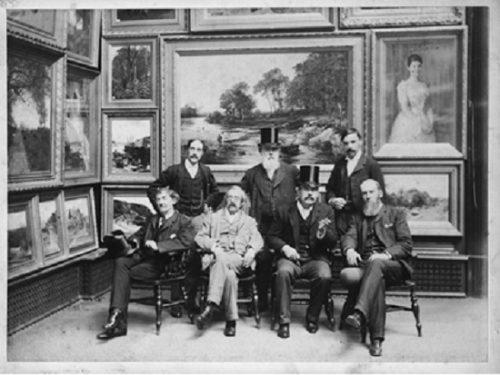
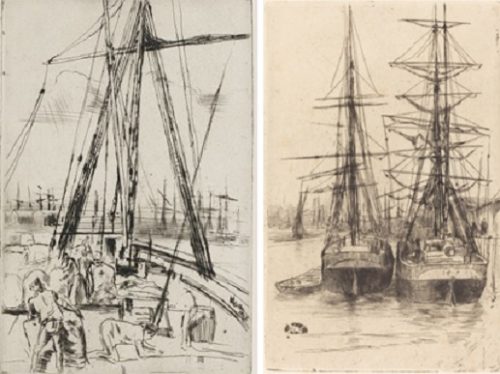 Shipping at Liverpool (1867) and The Two Ships (1875) by James McNeill Whistler
My research for the Whistler & Pennell: Etching the City exhibition at the Lady Lever Art Gallery uncovered some really interesting information about James McNeill Whistler (1834-1903) and his connection to Liverpool and Lancashire area. When Whistler was a young boy he travelled back and forth from Russia between 1843 and 1849. The family moved from America to Russia while Whistler’s father, George Washington Whistler, worked as an engineer on the railway from St Petersburg to Moscow. They sailed to Russia via Liverpool, docking at Liverpool at 6am on the 29th of August 1843. Liverpool was the first ever city Whistler encountered in Britain so it’s possible that his first impressions, formed while travelling along the River Mersey early that morning, inspired Whistler’s life long passion for rivers. The experience informed his much loved atmospheric river paintings, which he described as ‘Nocturnes’. They then travelled to Preston to visit his mother’s half-sister, Eliza, who had married a Preston solicitor John Winstanley.
Shipping at Liverpool (1867) and The Two Ships (1875) by James McNeill Whistler
My research for the Whistler & Pennell: Etching the City exhibition at the Lady Lever Art Gallery uncovered some really interesting information about James McNeill Whistler (1834-1903) and his connection to Liverpool and Lancashire area. When Whistler was a young boy he travelled back and forth from Russia between 1843 and 1849. The family moved from America to Russia while Whistler’s father, George Washington Whistler, worked as an engineer on the railway from St Petersburg to Moscow. They sailed to Russia via Liverpool, docking at Liverpool at 6am on the 29th of August 1843. Liverpool was the first ever city Whistler encountered in Britain so it’s possible that his first impressions, formed while travelling along the River Mersey early that morning, inspired Whistler’s life long passion for rivers. The experience informed his much loved atmospheric river paintings, which he described as ‘Nocturnes’. They then travelled to Preston to visit his mother’s half-sister, Eliza, who had married a Preston solicitor John Winstanley.
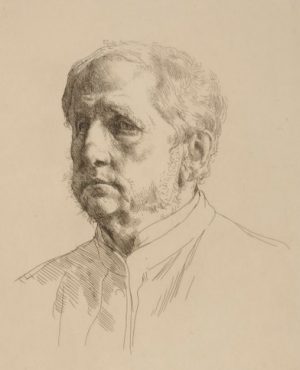 Sir Francis Seymour Hayden by William Strang, 1883
By the summer of 1847 Whistler’s half-sister Deborah, who featured in Whistler’s early work ‘At the Piano’ (1858-9) now in the Taft Museum, Ohio, had met the prominent young surgeon, Sir Francis Seymour Haden. They were married in Preston and Whistler at 13 years old, acted as groomsman on their big day in October that year. Owing to a Cholera epidemic in Russia Whistler’s father died in 1849 and the family began making plans to return to America. Before setting sail from Liverpool, they visited Preston again and travelled north to Edinburgh and Glasgow, where Whistler’s mother had family connections. Whistler was very proud of his Scottish heritage, and he included his mother’s maiden name ‘McNeill’ in his own.
Sir Francis Seymour Hayden by William Strang, 1883
By the summer of 1847 Whistler’s half-sister Deborah, who featured in Whistler’s early work ‘At the Piano’ (1858-9) now in the Taft Museum, Ohio, had met the prominent young surgeon, Sir Francis Seymour Haden. They were married in Preston and Whistler at 13 years old, acted as groomsman on their big day in October that year. Owing to a Cholera epidemic in Russia Whistler’s father died in 1849 and the family began making plans to return to America. Before setting sail from Liverpool, they visited Preston again and travelled north to Edinburgh and Glasgow, where Whistler’s mother had family connections. Whistler was very proud of his Scottish heritage, and he included his mother’s maiden name ‘McNeill’ in his own.
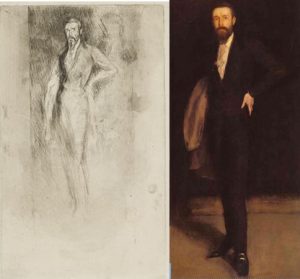 FR Leyland 1874 to1875 etching and painting by James McNeill Whistler
In 1867 Whistler was introduced to the prominent Liverpool ship-owner and art patron Frederick Leyland by the Pre-Raphaelite Dante Gabriel Rossetti. Leyland and his family lived at Speke Hall near Liverpool. He became Whistler’s most important patron and is credited for suggesting the term ’Nocturne’ to describe his famous moonlit river paintings. Whistler visited Leyland regularly at Speke Hall for many years and Liverpool was the only city outside London that Whistler travelled to frequently. It was during this time that Whistler made beautiful etchings of Liverpool, Speke Hall and the Leyland family.
FR Leyland 1874 to1875 etching and painting by James McNeill Whistler
In 1867 Whistler was introduced to the prominent Liverpool ship-owner and art patron Frederick Leyland by the Pre-Raphaelite Dante Gabriel Rossetti. Leyland and his family lived at Speke Hall near Liverpool. He became Whistler’s most important patron and is credited for suggesting the term ’Nocturne’ to describe his famous moonlit river paintings. Whistler visited Leyland regularly at Speke Hall for many years and Liverpool was the only city outside London that Whistler travelled to frequently. It was during this time that Whistler made beautiful etchings of Liverpool, Speke Hall and the Leyland family.
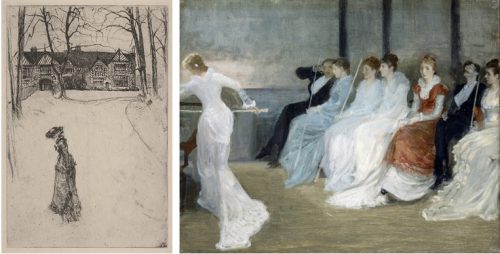 Speke Hall: The Avenue 1870-1878, etching by James McNeill Whistler and
Speke Hall: The Avenue 1870-1878, etching by James McNeill Whistler and JM Whistler and the Family of FR Leyland at Speke Hall, Liverpool by a British School artist from the collection of the Walker Art Gallery Whistler was also rumoured to have been engaged to Elizabeth Dawson, Leyland’s sister-in-law. Little is known about the engagement, but it was broken off shortly before Whistler and Leyland’s famous falling-out over the ‘Peacock Room’ which is now preserved at the Freer Gallery of Art in Washington DC. Whistler also had other patrons in Liverpool such as the engineer and industrialist Alfred Chapman. Whistler’s most famous portrait, ‘Arrangement in Grey and Black’, more commonly known as ‘Whistler’s Mother’ now in the Musee d'Orsay, Paris was exhibited at the Liverpool Autumn Exhibition at Walker Art Gallery in 1972. Two years later, James Anderson Rose, Whistler’s solicitor and a keen art collector, organised an exhibition of Whistler’s etchings at the Liverpool Art Club. The Chairman of the Arts and Exhibition sub-committee, Philip Rathbone, from the great Liverpool ship-owning family and who ran the Walker Art Gallery, was good friends with Whistler. He invited him to be the principal hanger at the 1891 Liverpool Autumn Exhibition. It was admired by everyone and in the 1895 Liverpool Autumn Exhibition, they hung a Whistler room which displayed pictures painted in the style of Whistler.
 Whistler on the hanging committee at the Liverpool Autumn Exhibition, Walker Art Gallery, 1891
Liverpool played a big part in Whistler’s life and he must have enjoyed his time in the city to have kept returning. The etchings he produced are a testament to his experiences in Liverpool.
The Whistler and Pennell: Etching the city exhibition is open daily at the Lady Lever Art Gallery from 10am to 5pm and is free to enter.
Whistler on the hanging committee at the Liverpool Autumn Exhibition, Walker Art Gallery, 1891
Liverpool played a big part in Whistler’s life and he must have enjoyed his time in the city to have kept returning. The etchings he produced are a testament to his experiences in Liverpool.
The Whistler and Pennell: Etching the city exhibition is open daily at the Lady Lever Art Gallery from 10am to 5pm and is free to enter.
